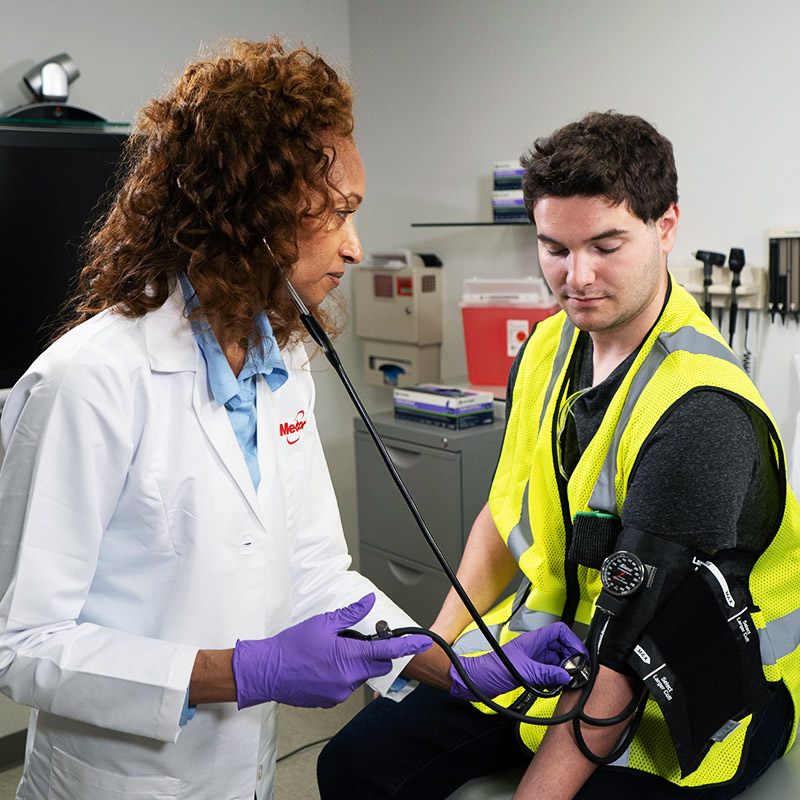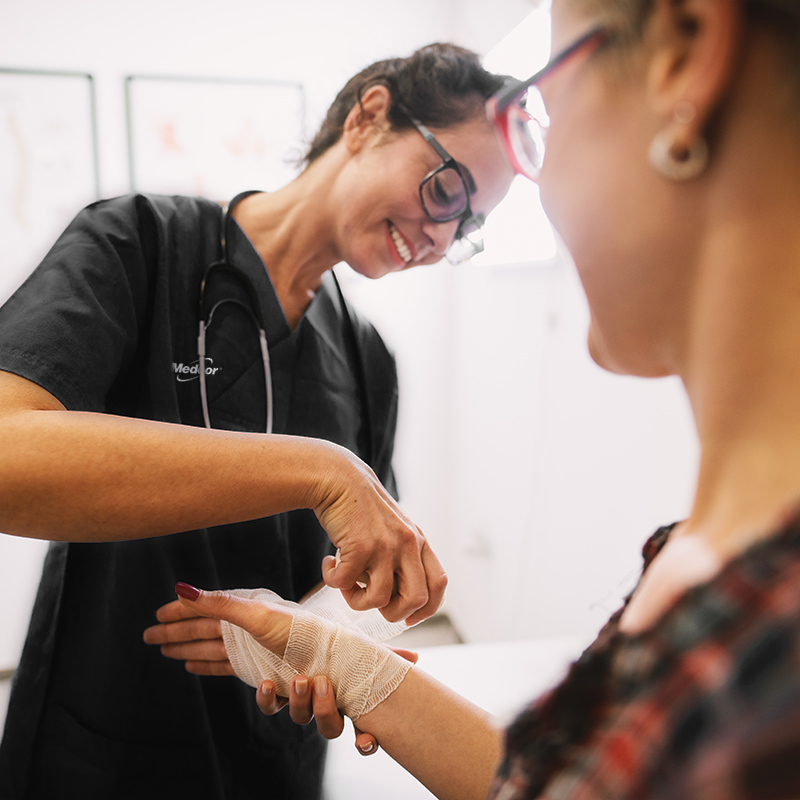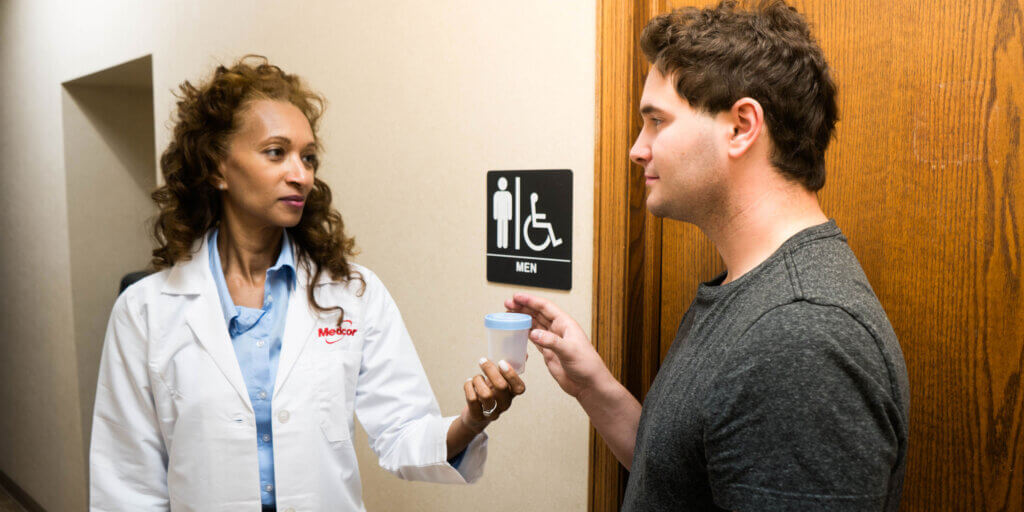Onsite Clinics
Onsite Services With Better Care at Lower Costs
Onsite health clinics for your workplace help keep your employees from getting lost on the trail of the traditional healthcare process. This improves your employees’ health and wellbeing while preventing overtreatment and avoiding unnecessary claims.
Medcor’s onsite clinics also provide health navigation — guiding injured and sick employees to the correct level of in-network care only when medically necessary and their needs cannot be handled by the onsite clinic’s scope of care. This approach provides a better experience for employees while removing the burden from employers. With an onsite health clinic from Medcor, you can provide prompt access to quality care while controlling your overall costs.

Our onsite clinics can be located in or near your business, offering care for on-the-job injuries or essential care services that improve your workers’ overall health. Having an onsite clinic ensures convenient access for employees (including walk-in, same day and virtual appointments) and reduces time away from work to obtain care. Being able to respond to injuries and illnesses quickly has been proven to improve outcomes, get employees back to work faster and reduce the cost of work-related injuries.
Medcor offers an onsite clinic solution to meet your company’s unique needs. Our specially trained healthcare staff provides more than just care for accidents at work; they can offer routine physical exams and health screenings, drug and alcohol testing programs, chronic condition screening and more. Onsite athletic trainers provided by Work RightNW can keep your employees healthier with our add-on Integrated Injury Prevention service, offering skilled workspace and worker assessments to stop injuries before they happen. Our onsite rehab programs further support employee recovery, ensuring they receive the right level of care for a faster and safer return to work.
How Onsite Clinics Increase Quality of Care
Bringing Medcor onsite to your workplace with an employee clinic means employees have an advocate who can help them with work-related injuries, preventative screenings, urgent care conditions, testing, return-to-work programs, preventative medicine, health coaching and more.
Because we are onsite, our early intervention means that health concerns are addressed before a claim can happen. When referrals are necessary, Medcor navigates patients through provider selection and the traditional healthcare system to ensure optimal health outcomes and the most cost savings. This convenient access to care ensures employee health is maintained, boosting productivity and reducing wait times for treatment.

Why Flexible Employee Health Programs Matter
In today’s fast-changing business environment, supporting employee wellbeing is key to maintaining a competitive edge. Flexible health programs allow businesses to adapt to shifting workforce needs, improving satisfaction, reducing costs and promoting long-term wellness.
Adapt to Changing Needs
As business priorities and employee demographics shift, flexible health programs allow companies to adjust benefits—whether adding mental health support or introducing telehealth services—ensuring employees get the right care at the right time.
Boost Employee Satisfaction
When employees see that their health needs are valued, engagement and retention improve. Tailored benefits like wellness workshops and stress management resources foster a healthier, more committed workforce.
Control Costs
Customizable health programs prevent overspending on unused services, directing resources to where they have the most impact—improving care quality while lowering costs.
Support Long-Term Wellness
Proactive, flexible health solutions help prevent future issues and create a healthier, more resilient workforce, strengthening employee loyalty and business performance.
Benefits of Onsite Clinics
Onsite health clinics provide your employees with convenient access to medical care for injuries and essential care services. For some workers, having convenient access is the difference between receiving routine care such as preventative screenings, injury and illness treatment and wellness services and delaying medical care. You benefit from a healthier workforce and increased productivity when your employees have easy access to care. By focusing on worksite health and offering comprehensive care, you ensure the long-term wellbeing of your employees.
- Encourage a Healthy Workforce
- Reduce Risks
- Prevent Unnecessary Claims
- Facilitate a Safe Return to Work
- Increase In-Network Provider Utilization
- Provide Care Consistency
Medcor’s Onsite Clinic Services
Medcor onsite clinics provide your employees with valuable health services, including:
Episodic Services
Episodic services are designed to address immediate healthcare needs and ensure your workforce remains healthy and productive. By offering services such as 24/7 Injury and Illness Triage, employees have off-hours access to quality care, facilitating next-day referrals to your onsite clinic. This reduces the costs associated with offsite medical care. For worksites too small to support a full clinic, our teletriage service provides a practical alternative.
Health and Wellness Services
-
Skilled therapists help workers recover swiftly, completing treatment plans and returning to work safely.
-
A systematic program ensures workplace safety, with site-specific surveillance for potential hazards and exposure to unregulated chemicals.
-
Employ proactive injury prevention strategies with ergonomic assessments and flexibility programs.
-
Onsite nurses conduct pre-hire, annual and post-injury exams, ensuring unbiased care navigation for better in-network service utilization.
-
Support employee health with coaching, mental wellness programs and lifestyle assessments, available both onsite and virtually.
-
Offer deeper care levels with routine physicals, chronic disease screenings and more, directly at the workplace.
-
Remove barriers to vaccinations by providing them onsite, addressing issues of time and access.
By integrating these episodic and health and wellness services, your organization can foster a healthier, more productive workforce, ultimately leading to a more efficient and satisfied team.
The Role of Actionable Insights in Onsite Health Programs
-
Track progress toward health objectives and employee wellness improvements.
-
Identify patterns to make timely adjustments and enhancements.
-
Focus investments on the most effective program areas.
-
Use continuous feedback to refine and improve outcomes.
-
Ensure the program stays relevant and drives ongoing improvements.
By transforming raw data into strategic knowledge, actionable insights help organizations maximize the effectiveness of their onsite health programs.



